Classification of Nitrogen-Efficient Wheat Varieties Based on UAV Hyperspectral Remote Sensing
Abstract
1. Introduction
2. Results
2.1. Subsection
2.2. Determination and Analysis of Nitrogen Stress-Tolerant Wheat
2.3. Classification of Nitrogen-Efficient Wheat Varieties Based on Hyperspectral Feature Bands
2.4. Classification of Nitrogen-Efficient Wheat Varieties at Normal Nitrogen Levels and Selection of Wheat Fertilization Strategies
3. Discussion
3.1. Effects of Different Nitrogen Stress Levels on Wheat Phenotype and Agronomic Indices
3.2. Correlation Analysis of Agronomic Indices and Classification of Nitrogen-Efficient Wheat Varieties Under Different Nitrogen Stress Treatments
3.3. Impact of Different Feature Selection and Classification Methods on Classifying Nitrogen-Efficient Wheat Varieties
3.4. The Advancement of Hyperspectral UAV Remote Sensing Technology in the Classification of Nitrogen-Efficient Wheat Varieties
3.5. Future Directions
4. Materials and Methods
4.1. Experimental Design
4.2. Wheat Phenotype Collection and Agronomic Index Calculation
4.3. Classification of Nitrogen-Efficient Wheat Varieties
4.4. Hyperspectral Data Collection
4.5. Development of Classification Model for Nitrogen-Efficient Wheat Varieties
4.5.1. Selection of Hyperspectral Characteristic Bands
4.5.2. Development of the Classification Model for Nitrogen-Efficient Wheat Varieties
4.5.3. Accuracy Evaluation
5. Conclusions
Author Contributions
Funding
Data Availability Statement
Conflicts of Interest
References
- Senapati, N.; Semenov, M.A.; Halford, N.G.; Hawkesford, M.J.; Asseng, S.; Cooper, M.; Ewert, F.; van Ittersum, M.K.; Martre, P.; Olesen, J.E.; et al. Global wheat production could benefit from closing the genetic yield gap. Nat. Food 2022, 3, 532–541. [Google Scholar] [CrossRef] [PubMed]
- Shewry, P.R.; Hey, S.J. The contribution of wheat to human diet and health. Food Energy Secur. 2015, 4, 178–202. [Google Scholar] [CrossRef] [PubMed]
- Shahane, A.A.; Shivay, Y.S. Chapter Five—Cereal crops: A valid option for bio-fortification and development of nutrient-dense food in developing and developed countries in Asia and Africa. In Advances in Agronomy; Sparks, D.L., Ed.; Academic Press: Cambridge, MA, USA, 2024; Volume 186, pp. 205–276. [Google Scholar]
- Ladha, J.K.; Pathak, H.; Krupnik, T.J.; Six, J.; van Kessel, C. Efficiency of Fertilizer Nitrogen in Cereal Production: Retrospects and Prospects. In Advances in Agronomy; Academic Press: Cambridge, MA, USA, 2005; Volume 87, pp. 85–156. [Google Scholar]
- Kumar, V.; Rithesh, L.; Raghuvanshi, N.; Kumar, A.; Parmar, K. Advancing nitrogen use efficiency in cereal crops: A comprehensive exploration of genetic manipulation, nitrogen dynamics, and plant nitrogen assimilation. S. Afr. J. Bot. 2024, 169, 486–498. [Google Scholar] [CrossRef]
- Zhang, Y.; Wu, H.; Yao, M.; Zhou, J.; Wu, K.; Hu, M.; Shen, H.; Chen, D. Estimation of nitrogen runoff loss from croplands in the Yangtze River Basin: A meta-analysis. Environ. Pollut. 2021, 272, 116001. [Google Scholar] [CrossRef]
- Hawkesford, M.J. Reducing the reliance on nitrogen fertilizer for wheat production. J. Cereal Sci. 2014, 59, 276–283. [Google Scholar] [CrossRef]
- Todd, J.; Johnson, R.; Verdun, D.; Richard, K. Identification of Selection Preferences and Predicting Yield Related Traits in Sugarcane Seedling Families Using RGB Spectral Indices. Agriculture 2022, 12, 1313. [Google Scholar] [CrossRef]
- Dhakal, R.; Huntjens, B.; Shah, R.; Lawrenson, J.G.; Verkicharla, P.K. Influence of location, season and time of day on the spectral composition of ambient light: Investigation for application in myopia. Ophthalmic Physiol. Opt. 2023, 43, 220–230. [Google Scholar] [CrossRef]
- Li, H.; Zhu, X.; Wang, J.; Wei, Y.; Nai, F.; Yu, H.; Wang, X. Unraveling differential characteristics and mechanisms of nitrogen uptake in wheat cultivars with varied nitrogen use efficiency. Plant Physiol. Biochem. 2024, 206, 108278. [Google Scholar] [CrossRef]
- Zhang, F.; Gao, S.; Zhao, Y.; Zhao, X.; Liu, X.; Xiao, K. Growth traits and nitrogen assimilation-associated physiological parameters of wheat (Triticum aestivum L.) under low and high N conditions. J. Integr. Agric. 2015, 14, 1295–1308. [Google Scholar] [CrossRef]
- Barraclough, P.B.; Howarth, J.R.; Jones, J.; Lopez-Bellido, R.; Parmar, S.; Shepherd, C.E.; Hawkesford, M.J. Nitrogen efficiency of wheat: Genotypic and environmental variation and prospects for improvement. Eur. J. Agron. 2010, 33, 1–11. [Google Scholar] [CrossRef]
- Kichey, T.; Hirel, B.; Heumez, E.; Dubois, F.; Le Gouis, J. In winter wheat (Triticum aestivum L.), post-anthesis nitrogen uptake and remobilisation to the grain correlates with agronomic traits and nitrogen physiological markers. Field Crops Res. 2007, 102, 22–32. [Google Scholar] [CrossRef]
- Le Gouis, J.; Béghin, D.; Heumez, E.; Pluchard, P. Genetic differences for nitrogen uptake and nitrogen utilisation efficiencies in winter wheat. Eur. J. Agron. 2000, 12, 163–173. [Google Scholar] [CrossRef]
- Triboi, E.; Martre, P.; Girousse, C.; Ravel, C.; Triboi-Blondel, A.-M. Unravelling environmental and genetic relationships between grain yield and nitrogen concentration for wheat. Eur. J. Agron. 2006, 25, 108–118. [Google Scholar] [CrossRef]
- Zhang, K.; Yan, F.; Liu, P. The application of hyperspectral imaging for wheat biotic and abiotic stress analysis: A review. Comput. Electron. Agric. 2024, 221, 109008. [Google Scholar] [CrossRef]
- Wang, Y.; Hu, W.; Li, L.; Duan, L.; Guo, T. Differences in Grain Yield, Nitrogen Efficiency of Different Genotypes of Winter Wheat and Their Correlations. J. Triticeae Crops 2013, 33, 301–308. [Google Scholar] [CrossRef]
- Sahameh, S.; Martin, L.L.; Ingunn, B.; Arne, D.J.; Muath, A.; Morten, L. Sequential forward selection and support vector regression in comparison to LASSO regression for spring wheat yield prediction based on UAV imagery. Comput. Electron. Agric. 2021, 183, 106036. [Google Scholar] [CrossRef]
- Gao, J.; Liao, W.; Nuyttens, D.; Lootens, P.; Xue, W.; Alexandersson, E.; Pieters, J. Cross-domain transfer learning for weed segmentation and mapping in precision farming using ground and UAV images. Expert Syst. Appl. 2024, 246, 122980. [Google Scholar] [CrossRef]
- Wijayanto, A.K.; Prasetyo, L.B.; Hudjimartsu, S.A.; Sigit, G.; Hongo, C. Advanced BLB disease assessment in paddy fields using multispectral UAV data and patch fragmentation metrics. Smart Agric. Technol. 2025, 10, 100766. [Google Scholar] [CrossRef]
- Tetila, E.C.; Machado, B.B.; Astolfi, G.; Belete, N.A.d.S.; Amorim, W.P.; Roel, A.R.; Pistori, H. Detection and classification of soybean pests using deep learning with UAV images. Comput. Electron. Agric. 2020, 179, 105836. [Google Scholar] [CrossRef]
- Qiao, L.; Zhao, R.; Tang, W.; An, L.; Sun, H.; Li, M.; Wang, N.; Liu, Y.; Liu, G. Estimating maize LAI by exploring deep features of vegetation index map from UAV multispectral images. Field Crops Res. 2022, 289, 108739. [Google Scholar] [CrossRef]
- Huang, J.; He, F.; Cui, K.; Buresh, R.J.; Xu, B.; Gong, W.; Peng, S. Determination of optimal nitrogen rate for rice varieties using a chlorophyll meter. Field Crops Res. 2008, 105, 70–80. [Google Scholar] [CrossRef]
- Guo, Y.; Xiao, Y.; Hao, F.; Zhang, X.; Chen, J.; de Beurs, K.; He, Y.; Fu, Y.H. Comparison of different machine learning algorithms for predicting maize grain yield using UAV-based hyperspectral images. Int. J. Appl. Earth Obs. Geoinf. 2023, 124, 103528. [Google Scholar] [CrossRef]
- Jiang, J.; Atkinson, P.M.; Zhang, J.; Lu, R.; Zhou, Y.; Cao, Q.; Tian, Y.; Zhu, Y.; Cao, W.; Liu, X. Combining fixed-wing UAV multispectral imagery and machine learning to diagnose winter wheat nitrogen status at the farm scale. Eur. J. Agron. 2022, 138, 126537. [Google Scholar] [CrossRef]
- Dong, D. Identification of Nitrogen Efficiency and Inversion of Photosynthetic Efficiency and Grain Protein Content in Winter Wheat. Master’s thesis, Xinjiang Agricultural University, Urumqi, China, 2022. [Google Scholar]
- Wan, L.; Zhou, W.; He, Y.; Wanger, T.C.; Cen, H. Combining transfer learning and hyperspectral reflectance analysis to assess leaf nitrogen concentration across different plant species datasets. Remote Sens. Environ. 2022, 269, 112826. [Google Scholar] [CrossRef]
- Feng, W.; Yao, X.; Zhu, Y.; Tian, Y.C.; Cao, W.X. Monitoring leaf nitrogen status with hyperspectral reflectance in wheat. Eur. J. Agron. 2008, 28, 394–404. [Google Scholar] [CrossRef]
- Zhang, Y.; Hui, J.; Qin, Q.; Sun, Y.; Zhang, T.; Sun, H.; Li, M. Transfer-learning-based approach for leaf chlorophyll content estimation of winter wheat from hyperspectral data. Remote Sens. Environ. 2021, 267, 112724. [Google Scholar] [CrossRef]
- Xu, A.; Khan, K.S.; Wei, X.; Chen, Y.; Zhou, Y.; Sun, C.; Effah, Z.; Li, L. Fertilizer nitrogen use efficiency and its fate in the spring wheat-soil system under varying N-fertilizer rates: A two-year field study using 15N tracer. Soil Tillage Res. 2025, 252, 106612. [Google Scholar] [CrossRef]
- Li, G.; Ren, X.; Pang, S.; Feng, C.; Niu, Y.; Qu, Y.; Liu, C.; Lin, X.; Wang, D. Nitrogen redistribution during the grain-filling stage and its correlation with senescence and TaATG8 expression in leaves of winter wheat. J. Integr. Agric. 2024, in press. [CrossRef]
- Rossini, A.; Ruggeri, R.; Rossini, F. Combining nitrogen fertilization and biostimulant application in durum wheat: Effects on morphophysiological traits, grain production, and quality. Ital. J. Agron. 2025, 20, 100027. [Google Scholar] [CrossRef]
- Sarker, U.K.; Uddin, M.R.; Hossain, M.A.; Somaddar, U.; Saha, G. Exploring relationship among nitrogen fertilizer, yield and nitrogen use efficiency in modern wheat varieties under subtropical condition. Saudi J. Biol. Sci. 2023, 30, 103602. [Google Scholar] [CrossRef]
- Li, H.; Liang, Y.; Xu, Q.; Cao, D. Key wavelengths screening using competitive adaptive reweighted sampling method for multivariate calibration. Anal. Chim. Acta 2009, 648, 77–84. [Google Scholar] [CrossRef]
- Mei, Z.; Shi, Z. On LASSO for high dimensional predictive regression. J. Econom. 2024, 242, 105809. [Google Scholar] [CrossRef]
- Wang, D.; Struik, P.C.; Liang, L.; Yin, X. Estimating leaf and canopy nitrogen contents in major field crops across the growing season from hyperspectral images using nonparametric regression. Comput. Electron. Agric. 2025, 233, 110147. [Google Scholar] [CrossRef]
- Homolová, L.; Malenovský, Z.; Clevers, J.G.P.W.; García-Santos, G.; Schaepman, M.E. Review of optical-based remote sensing for plant trait mapping. Ecol. Complex. 2013, 15, 1–16. [Google Scholar] [CrossRef]
- Wang, L.; Zhou, X.; Zhu, X.; Guo, W. Estimation of leaf nitrogen concentration in wheat using the MK-SVR algorithm and satellite remote sensing data. Comput. Electron. Agric. 2017, 140, 327–337. [Google Scholar] [CrossRef]
- Zhou, W.; Liu, Y.; Ata-Ul-Karim, S.T.; Ge, Q.; Li, X.; Xiao, J. Integrating climate and satellite remote sensing data for predicting county-level wheat yield in China using machine learning methods. Int. J. Appl. Earth Obs. Geoinf. 2022, 111, 102861. [Google Scholar] [CrossRef]
- Graf, L.V.; Merz, Q.N.; Walter, A.; Aasen, H. Insights from field phenotyping improve satellite remote sensing based in-season estimation of winter wheat growth and phenology. Remote Sens. Environ. 2023, 299, 113860. [Google Scholar] [CrossRef]
- Gong, Z.; Ge, W.; Guo, J.; Liu, J. Satellite remote sensing of vegetation phenology: Progress, challenges, and opportunities. ISPRS J. Photogramm. Remote Sens. 2024, 217, 149–164. [Google Scholar] [CrossRef]
- Yuan, L.; Yu, Q.; Xiang, L.; Zeng, F.; Dong, J.; Xu, O.; Zhang, J. Integrating UAV and high-resolution satellite remote sensing for multi-scale rice disease monitoring. Comput. Electron. Agric. 2025, 234, 110287. [Google Scholar] [CrossRef]



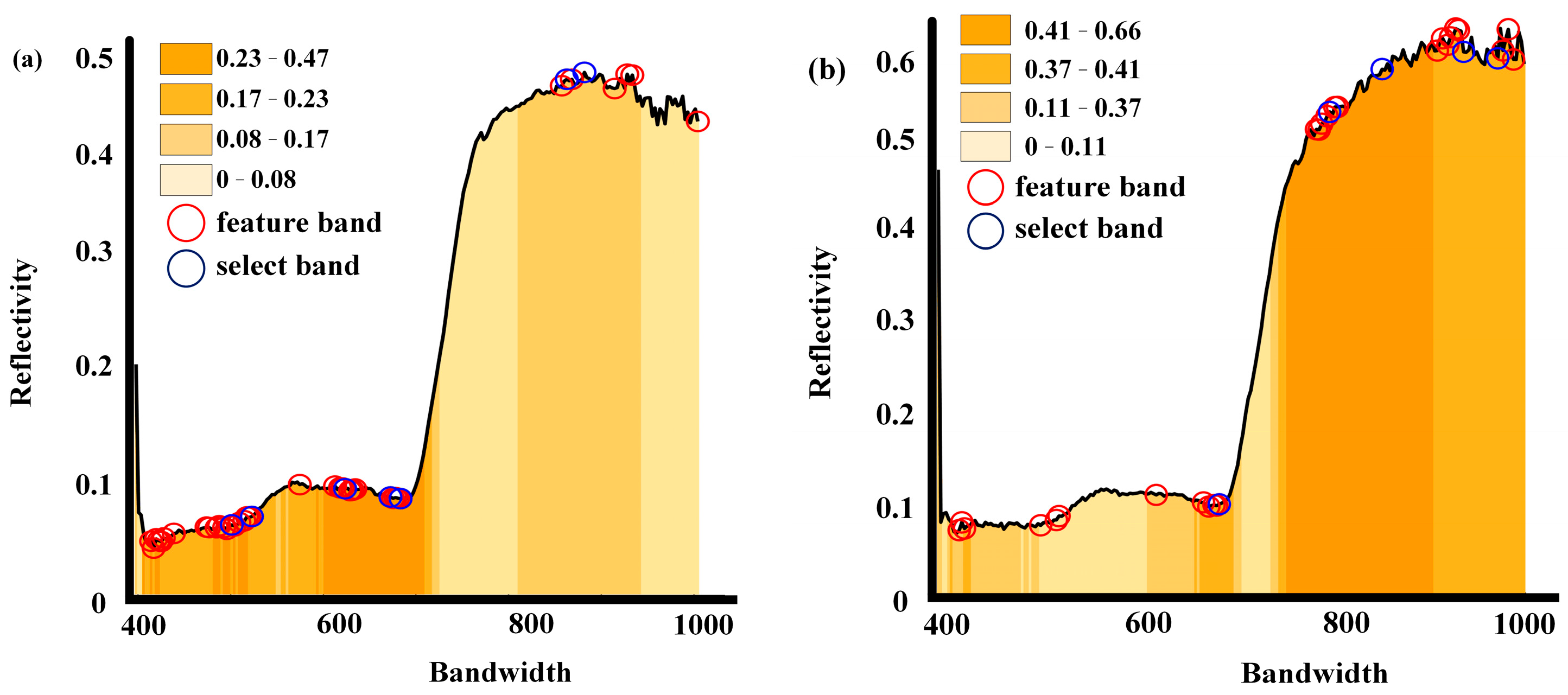
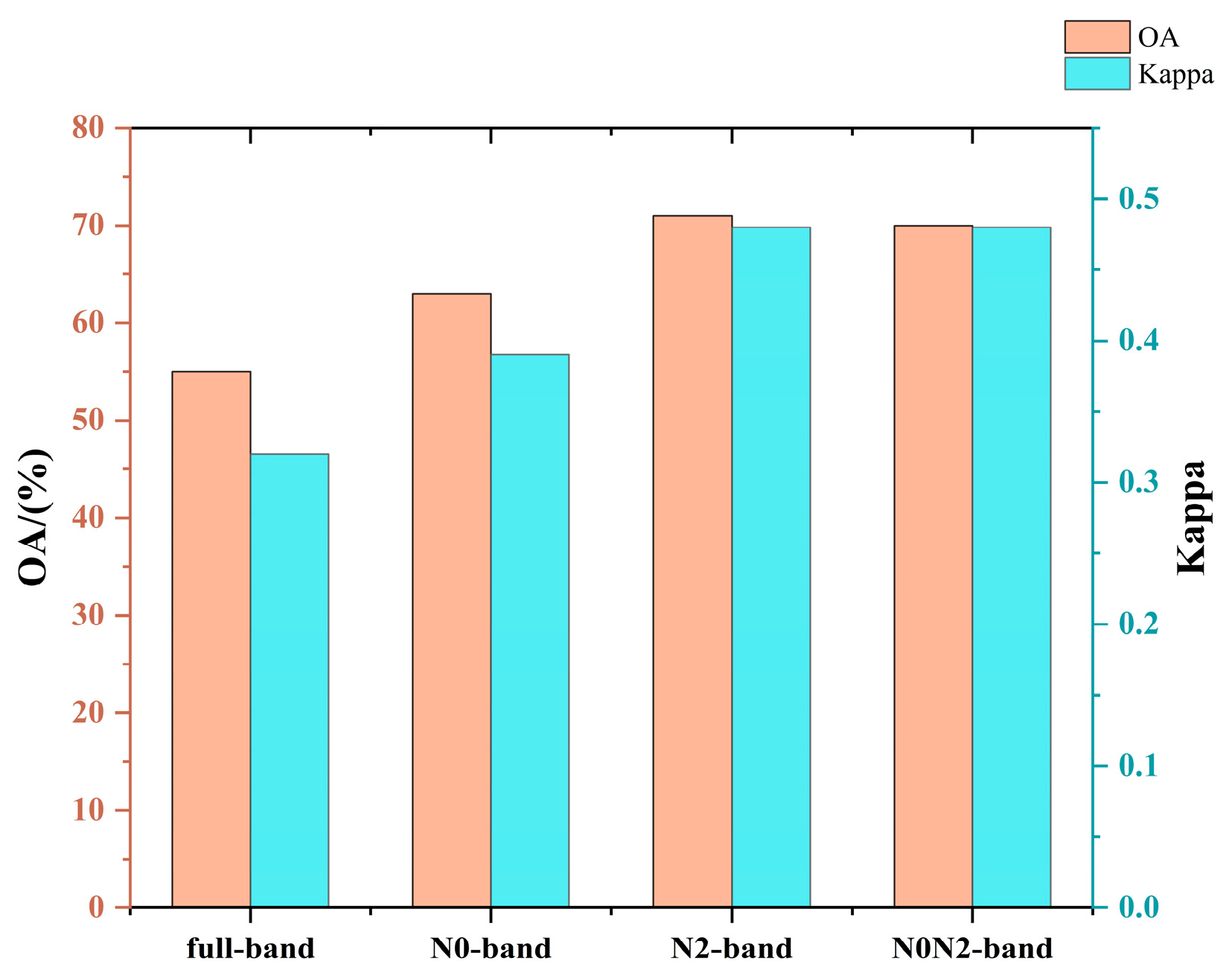
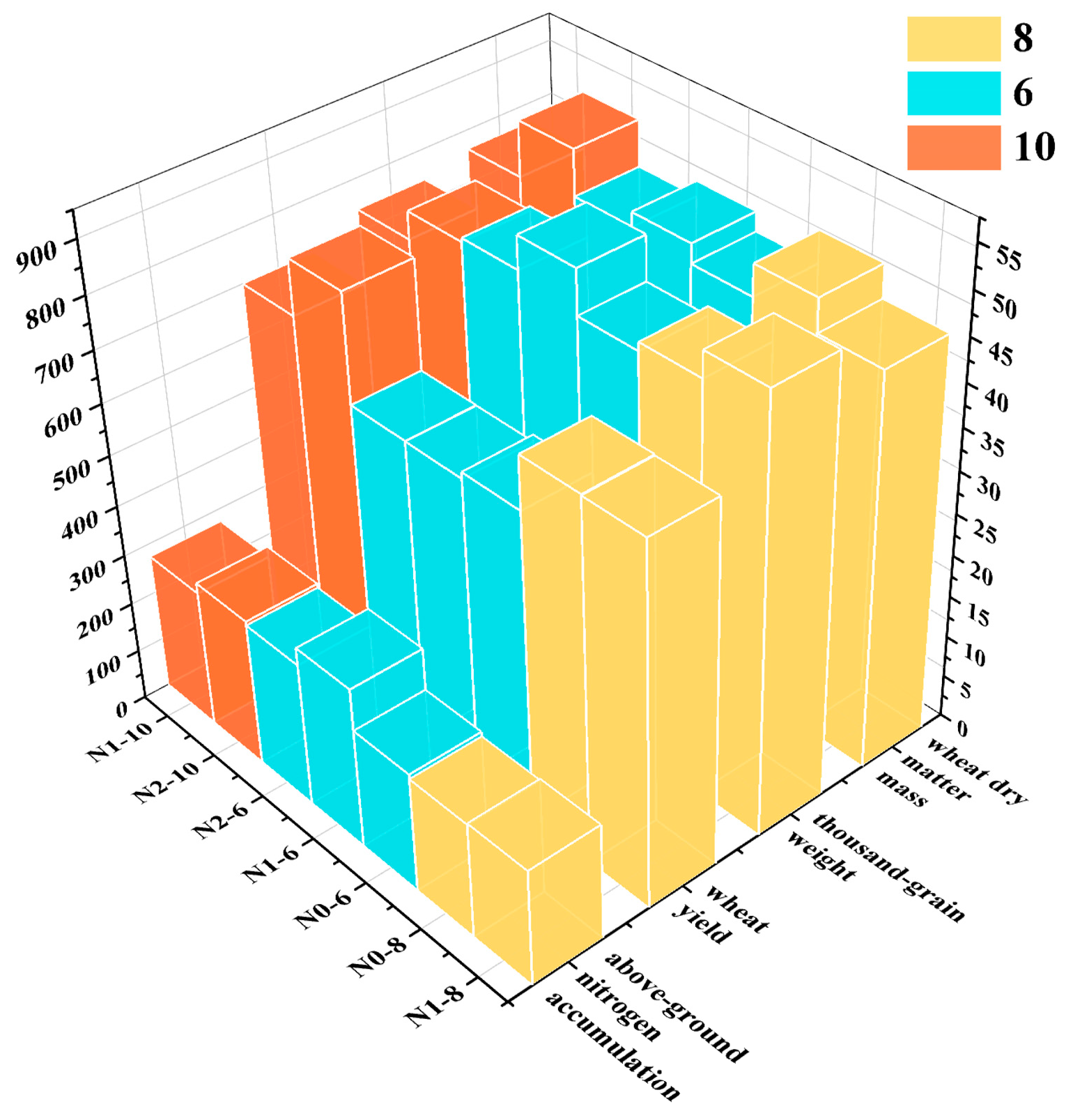

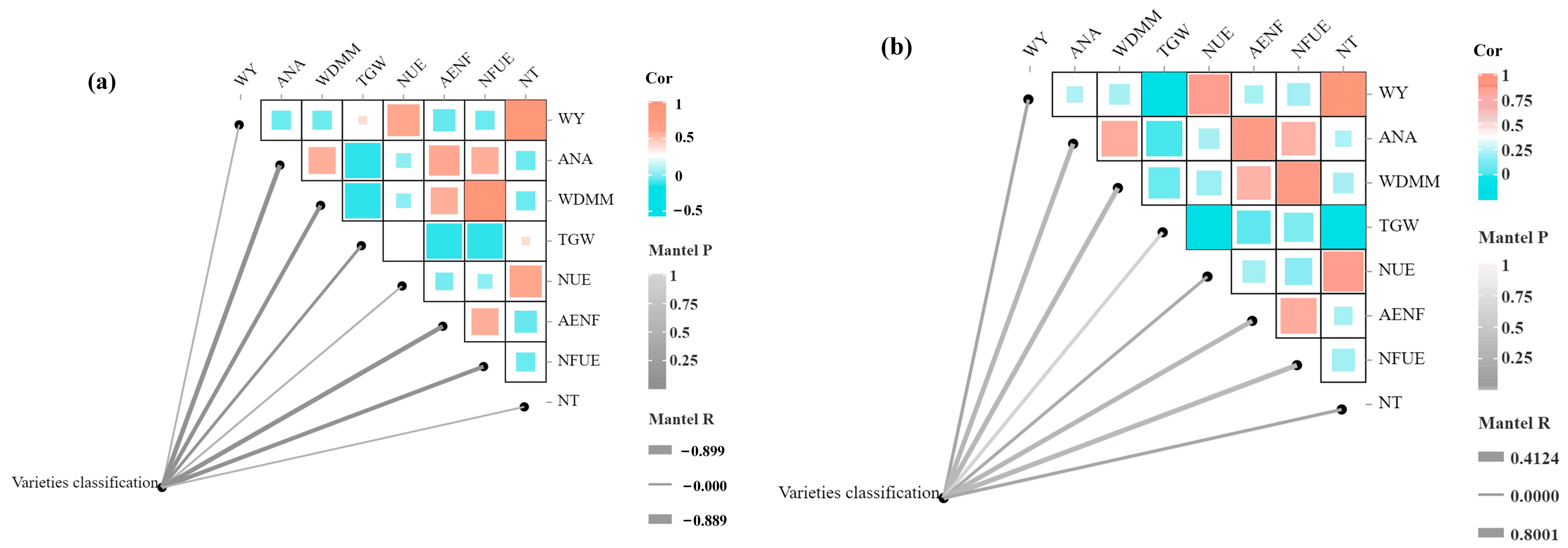
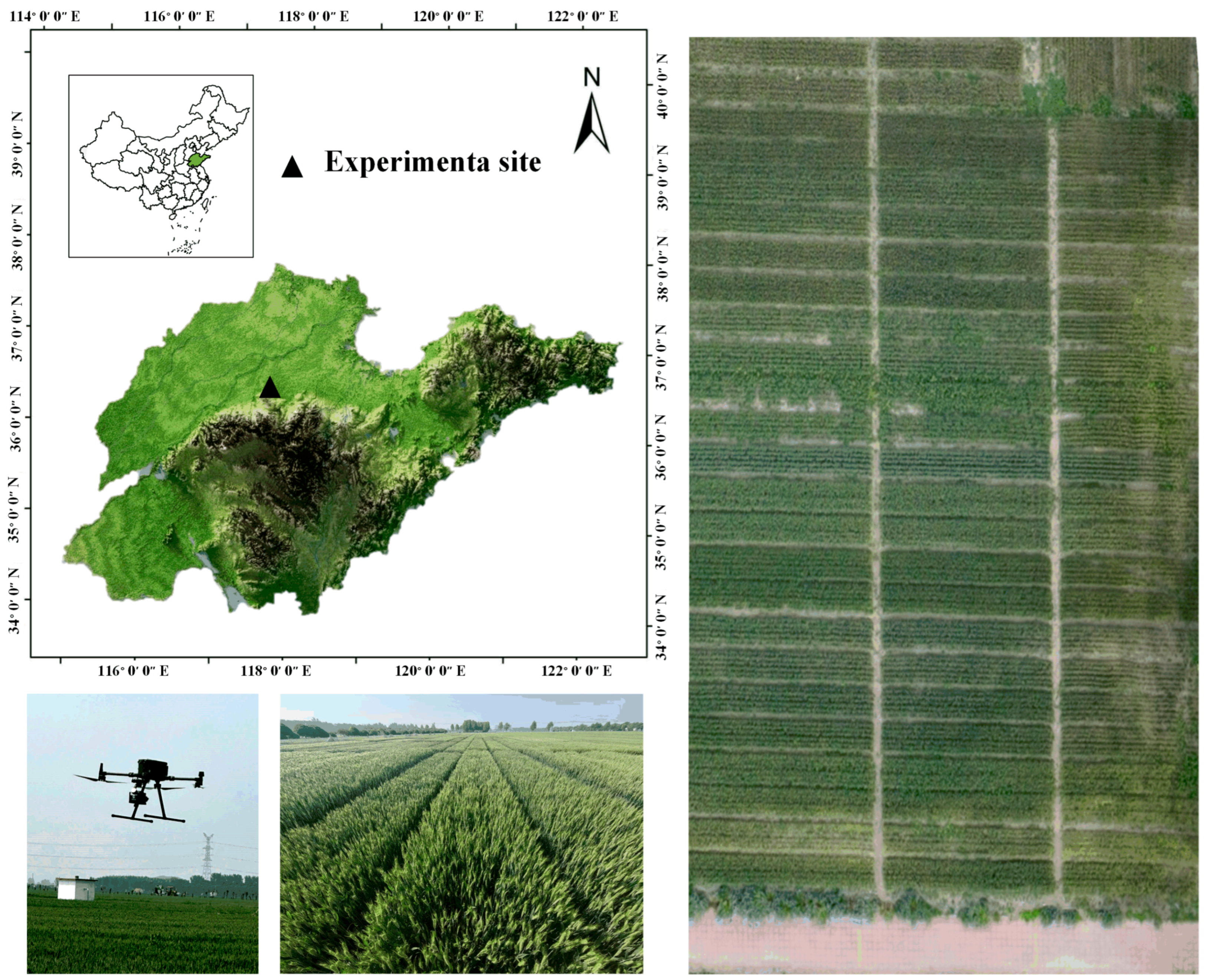

| Agronomic Indices | WY | ANA | WDMM | TGW | UNE | AENF | NFUE | NT | |
|---|---|---|---|---|---|---|---|---|---|
| Item | |||||||||
| Max | 10% | −1% | 11% | 17% | 2.68 | −0.0002 | 0.098 | 1.095 | |
| Min | −8% | −30% | −25% | −18% | −2.597 | −0.009 | −0.349 | 0.918 | |
| SD | 0.0515 | 0.105 | 0.096 | 0.0978 | 1.445 | 0.003 | 0.118 | 0.051 | |
| Mean | −0.004 | −0.173 | −0.115 | −0.008 | −0.149 | −0.005 | −0.145 | 0.996 | |
| CV | 13.37% | 0.60% | 0.83% | 11.94% | 9.72% | 0.66% | 0.81% | 0.05% | |
| Agronomic Indices | WY | ANA | WDMM | TGW | UNE | AENF | NFUE | NT | |
|---|---|---|---|---|---|---|---|---|---|
| Item | |||||||||
| Max | 13% | 23% | 24% | 14% | 3.557 | 0.005 | 0.213 | 1.12 | |
| Min | −10% | −12% | −10% | −12% | −3.133 | −0.004 | −0.121 | 0.900 | |
| SD | 0.059 | 0.109 | 0.109 | 0.083 | 1.761 | 0.003 | 0.111 | 0.059 | |
| Mean | −0.006 | 0.006 | 0.019 | 0.004 | −0.243 | −0.00013 | 0.011 | 0.994 | |
| CV | 10.43% | 17.08% | 5.56% | 19.29% | 7.25% | 20.00% | 10.21% | 0.06% | |
| Models | SVM-XGBoost | SVM | RF | XGBoost | Adaboost | ||||||
|---|---|---|---|---|---|---|---|---|---|---|---|
| Nitrogen Situation | OA (%) | Kappa | OA (%) | Kappa | OA (%) | Kappa | OA (%) | Kappa | OA (%) | Kappa | |
| Low-nitrogen stress | 74 | 0.67 | 55 | 0.55 | 65 | 0.41 | 69 | 0.38 | 65 | 0.40 | |
| High-nitrogen stress | 83 | 0.80 | 79 | 0.79 | 76 | 0.68 | 76 | 0.74 | 79 | 0.72 | |
| Mean | 78.5 | 0.74 | 67 | 0.67 | 70.5 | 0.55 | 72.5 | 0.56 | 72 | 0.56 | |
| Bands | Full Band | CARS | Lasso | Lasso-CARS | |||||
|---|---|---|---|---|---|---|---|---|---|
| Nitrogen Situation | OA(%) | Kappa | OA(%) | Kappa | OA(%) | Kappa | OA(%) | Kappa | |
| Low-nitrogen stress | 65 | 0.35 | 69 | 0.52 | 65 | 0.51 | 74 | 0.67 | |
| High-nitrogen stress | 73 | 0.67 | 80 | 0.74 | 79 | 0.73 | 83 | 0.80 | |
| Mean | 69 | 0.51 | 74.5 | 0.63 | 72 | 0.62 | 78.5 | 0.74 | |
Disclaimer/Publisher’s Note: The statements, opinions and data contained in all publications are solely those of the individual author(s) and contributor(s) and not of MDPI and/or the editor(s). MDPI and/or the editor(s) disclaim responsibility for any injury to people or property resulting from any ideas, methods, instructions or products referred to in the content. |
© 2025 by the authors. Licensee MDPI, Basel, Switzerland. This article is an open access article distributed under the terms and conditions of the Creative Commons Attribution (CC BY) license (https://creativecommons.org/licenses/by/4.0/).
Share and Cite
Li, Y.; Wang, C.; Zhu, J.; Wang, Q.; Liu, P. Classification of Nitrogen-Efficient Wheat Varieties Based on UAV Hyperspectral Remote Sensing. Plants 2025, 14, 1908. https://doi.org/10.3390/plants14131908
Li Y, Wang C, Zhu J, Wang Q, Liu P. Classification of Nitrogen-Efficient Wheat Varieties Based on UAV Hyperspectral Remote Sensing. Plants. 2025; 14(13):1908. https://doi.org/10.3390/plants14131908
Chicago/Turabian StyleLi, Yumeng, Chunying Wang, Junke Zhu, Qinglong Wang, and Ping Liu. 2025. "Classification of Nitrogen-Efficient Wheat Varieties Based on UAV Hyperspectral Remote Sensing" Plants 14, no. 13: 1908. https://doi.org/10.3390/plants14131908
APA StyleLi, Y., Wang, C., Zhu, J., Wang, Q., & Liu, P. (2025). Classification of Nitrogen-Efficient Wheat Varieties Based on UAV Hyperspectral Remote Sensing. Plants, 14(13), 1908. https://doi.org/10.3390/plants14131908






